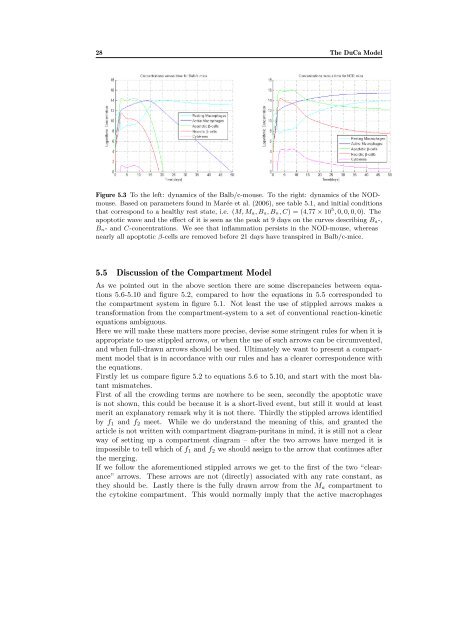nr. 477 - 2011 - Institut for Natur, Systemer og Modeller (NSM)
nr. 477 - 2011 - Institut for Natur, Systemer og Modeller (NSM)
nr. 477 - 2011 - Institut for Natur, Systemer og Modeller (NSM)
Create successful ePaper yourself
Turn your PDF publications into a flip-book with our unique Google optimized e-Paper software.
28 The DuCa Model<br />
Figure 5.3 To the left: dynamics of the Balb/c-mouse. To the right: dynamics of the NODmouse.<br />
Based on parameters found in Marée et al. (2006), see table 5.1, and initial conditions<br />
that correspond to a healthy rest state, i.e. (M, Ma, Ba, Bn, C) = (4.77 × 10 5 , 0, 0, 0, 0). The<br />
apoptotic wave and the effect of it is seen as the peak at 9 days on the curves describing Ba-,<br />
Bn- and C-concentrations. We see that inflammation persists in the NOD-mouse, whereas<br />
nearly all apoptotic β-cells are removed be<strong>for</strong>e 21 days have transpired in Balb/c-mice.<br />
5.5 Discussion of the Compartment Model<br />
As we pointed out in the above section there are some discrepancies between equations<br />
5.6-5.10 and figure 5.2, compared to how the equations in 5.5 corresponded to<br />
the compartment system in figure 5.1. Not least the use of stippled arrows makes a<br />
trans<strong>for</strong>mation from the compartment-system to a set of conventional reaction-kinetic<br />
equations ambiguous.<br />
Here we will make these matters more precise, devise some stringent rules <strong>for</strong> when it is<br />
appropriate to use stippled arrows, or when the use of such arrows can be circumvented,<br />
and when full-drawn arrows should be used. Ultimately we want to present a compartment<br />
model that is in accordance with our rules and has a clearer correspondence with<br />
the equations.<br />
Firstly let us compare figure 5.2 to equations 5.6 to 5.10, and start with the most blatant<br />
mismatches.<br />
First of all the crowding terms are nowhere to be seen, secondly the apoptotic wave<br />
is not shown, this could be because it is a short-lived event, but still it would at least<br />
merit an explanatory remark why it is not there. Thirdly the stippled arrows identified<br />
by f1 and f2 meet. While we do understand the meaning of this, and granted the<br />
article is not written with compartment diagram-puritans in mind, it is still not a clear<br />
way of setting up a compartment diagram – after the two arrows have merged it is<br />
impossible to tell which of f1 and f2 we should assign to the arrow that continues after<br />
the merging.<br />
If we follow the a<strong>for</strong>ementioned stippled arrows we get to the first of the two “clearance”<br />
arrows. These arrows are not (directly) associated with any rate constant, as<br />
they should be. Lastly there is the fully drawn arrow from the Ma compartment to<br />
the cytokine compartment. This would normally imply that the active macrophages
















